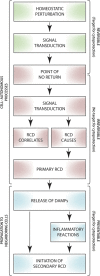Essential versus accessory aspects of cell death: recommendations of the NCCD 2015
- PMID: 25236395
- PMCID: PMC4262782
- DOI: 10.1038/cdd.2014.137
Essential versus accessory aspects of cell death: recommendations of the NCCD 2015
Abstract
Cells exposed to extreme physicochemical or mechanical stimuli die in an uncontrollable manner, as a result of their immediate structural breakdown. Such an unavoidable variant of cellular demise is generally referred to as 'accidental cell death' (ACD). In most settings, however, cell death is initiated by a genetically encoded apparatus, correlating with the fact that its course can be altered by pharmacologic or genetic interventions. 'Regulated cell death' (RCD) can occur as part of physiologic programs or can be activated once adaptive responses to perturbations of the extracellular or intracellular microenvironment fail. The biochemical phenomena that accompany RCD may be harnessed to classify it into a few subtypes, which often (but not always) exhibit stereotyped morphologic features. Nonetheless, efficiently inhibiting the processes that are commonly thought to cause RCD, such as the activation of executioner caspases in the course of apoptosis, does not exert true cytoprotective effects in the mammalian system, but simply alters the kinetics of cellular demise as it shifts its morphologic and biochemical correlates. Conversely, bona fide cytoprotection can be achieved by inhibiting the transduction of lethal signals in the early phases of the process, when adaptive responses are still operational. Thus, the mechanisms that truly execute RCD may be less understood, less inhibitable and perhaps more homogeneous than previously thought. Here, the Nomenclature Committee on Cell Death formulates a set of recommendations to help scientists and researchers to discriminate between essential and accessory aspects of cell death.
Figures




References
-
- Mazzarello P. A unifying concept: the history of cell theory. Nat Cell Biol. 1999;1:E13–E15. - PubMed
-
- Cotter TG. Apoptosis and cancer: the genesis of a research field. Nat Rev Cancer. 2009;9:501–507. - PubMed
-
- Schweichel JU, Merker HJ. The morphology of various types of cell death in prenatal tissues. Teratology. 1973;7:253–266. - PubMed
-
- Vaux DL. Apoptosis timeline. Cell Death Differ. 2002;9:349–354. - PubMed
-
- Pearson H. ‘Virophage' suggests viruses are alive. Nature. 2008;454:677. - PubMed
Publication types
MeSH terms
Grants and funding
- R01 GM096208/GM/NIGMS NIH HHS/United States
- R01 AA021191/AA/NIAAA NIH HHS/United States
- R01 GM053396/GM/NIGMS NIH HHS/United States
- MC_U132670600/MRC_/Medical Research Council/United Kingdom
- 233294/ERC_/European Research Council/International
- R01 CA169291/CA/NCI NIH HHS/United States
- R01 HD066319/HD/NICHD NIH HHS/United States
- R01 DK073336/DK/NIDDK NIH HHS/United States
- P01 HD029587/HD/NICHD NIH HHS/United States
- P50 DA000266/DA/NIDA NIH HHS/United States
- P50 NS038377/NS/NINDS NIH HHS/United States
- MR/M019217/1/MRC_/Medical Research Council/United Kingdom
- R01 CA130893/CA/NCI NIH HHS/United States
- R01 GM072124/GM/NIGMS NIH HHS/United States
- R01 NS086890/NS/NINDS NIH HHS/United States
- R56 DK037034/DK/NIDDK NIH HHS/United States
- R01 CA097061/CA/NCI NIH HHS/United States
- P01 CA080058/CA/NCI NIH HHS/United States
- R01 CA163591/CA/NCI NIH HHS/United States
- R01 CA170702/CA/NCI NIH HHS/United States
- R01 AI044828/AI/NIAID NIH HHS/United States
- 095317/WT_/Wellcome Trust/United Kingdom
- 100140/WT_/Wellcome Trust/United Kingdom
LinkOut - more resources
Full Text Sources
Other Literature Sources

